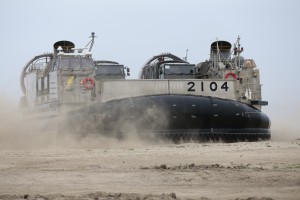[slidepress gallery=’11th-meu-and-the-japanese-self-defense-force-during-exercise-dawn-blitz’]
2013-06-06 Exercise Dawn Blitz 2013 is being held currently off the West Coast of the United States.
Dawn Blitz 2013 is a scenario-driven, simulation-supported amphibious exercise designed to train Expeditionary Strike Group 3 (ESG 3) and 1st Marine Expeditionary Brigade (1st MEB). The initial, synthetic scenario occurred Jan. 28-31, 2013 and the final live phase will be conducted June 11-28. Dawn Blitz provides a robust training environment where forces plan and execute an amphibious assault from a seabase in a land-and- maritime threat environment to improve naval amphibious core competencies.
It is also about coalition partners and those partners leveraging the exercise as part of their own force evolution process.
As Lt. General Robling, MARFORPAC, put it in a forthcoming interview:
Recently, a three ship Japanese flotilla on the way to the Dawn Blitz exercise stopped in Hawaii and I talked with a two-star Japanese Army general. His Army soldiers are on Navy ships and are getting ready to practice ship-to-shore movement and amphibious operations.
This is the future of land power in the Pacific. Robling was also asked a question about the Australian effort as well.
SLD: Recently we looked at the kind of reform the Australian Army is undergoing with changes associated with amphibious lift and other approaches to greater mobility. How important is the USN-USMC team to the kind of land power reforms going on in the region?
Lt. General Robling: It is very important. 7 of the 10 largest land armies in the world are in the Pacific region. But many of the allied armies are in transition and looking to work effectively on territorial defense, but at greater distance than simply looking out from their border defenses. This means greater mobility and we are receiving significant demand to work with these forces as they sort out how to reform in effectively and responsible ways.
The reality is that most of the landmasses in the Pacific are in the littorals. This means that maritime-ground operations are the way ahead, not simply landlocked operations.
(For more on Australia see the following:
In other words, the USN-USMC team are shaping a new approach to landpower for the 21st century.
The Japanese and Australians among others understand that the future of their Armies is shaping more expeditionary capabilities and to operate as a maneuver force. They will operate not as a “raiding force,” but a maneuver force from the sea and supported from the air.

The current Dawn Blitz exercise is clearly highlighting this trend as did the recently completed Bold Alligator 2013 exercise. We have just published a new Special Report. This one deals with Bold Alligator 2013 and complements an earlier one on Bold Alligator 2012.
This exercise tested out how to shape new ways to forge a capable insertion force using the seabase. Especially noteworthy has been the testing of approaches for seabase support to the ground forces. Indeed, the challenge has been to mix the deployed forces with the proper support element.
A light logistics footprint has meant that the overall force protection and support requirements have been reduced. Rather than building mobile Walmarts, which then need to be protected, the model here is to support the engaged force with the right equipment and right supplies at the right place.
A key challenge facing the U.S. and its allies is to ensure that the politicians and strategists understand this new and evolving flexibility and shape proper understanding of when and how to use this capability.
For example, with regard to Syria, the positions taken have largely been either to do a significant land insertion to support the “rebels” or to put red lines in the sand to ensure that chemical weapons are not used.
Not discussed at all was how might we use this new flexible force to go in and grab the weapons one can and leave, without fully resolving the fate of Syria for the 21st century.
Limited objectives, limited means but robust capabilities provide policy options, if the policy class puzzles over evolving capabilities.
As the United States faces the future and needs to come to terms with the past decade, what will be its military strategy?
The answer to this question is not likely to come in briefing slides but in shaping concrete steps towards the future as well as in shaping responses to new and ongoing crises.
Although nationally based, any U.S. military strategy for the decade ahead and beyond will be dependent on what U.S. allies and adversaries do. It will not be forged in a vacuum. It will be highly interactive with the shaping of new operational concepts and approaches.
Indeed, when the United States deals with a massive challenge such as shaping a strategy for the vast Pacific with limited assets, it is impossible to imagine a strategy that does not build from allies back to the United States and from the United States back to allies. Critics, who point out the shortfalls of US forces, often forget that not only does no platform fight alone, but also neither will the U.S. in the Pacific.
And there is always the reactive enemy. Often the term is used of an asymmetric enemy or strategy.
But strategy is usually asymmetric, as one seeks to enhance one’s advantages to the disadvantage of the other. And this occurs the other way as well, whereby the U.S. and its allies can shape capabilities that severely disadvantage an adversary.
With financial pressures has come a new pessimism, which seeks to reduce the problems facing the U.S. to those that can be solved by yesterday’s force structure. But with the force being remade by new technologies ripening in the decade ahead, there are significant possibilities for innovation and re-shaping of the force structure.
But the decade ahead is assuredly not the decade behind.
Most notably, this is not a decade of the type of land wars we have just seen, which are ending without enthusiastic chants of victory.
Because allies are more central to the successful execution of American political-military strategy in the decade ahead than in recent history, how those allies re-shape their forces and innovate will be central as well to the broader understanding of “American” strategy.
But this does not happen without introducing new systems, reshaping capabilities and crafting an effective force for the 21st century.
The United States, and its Allies need to analyze, conceive, and then build towards the force for the future.
We have seen recent engagements as coalitions, and thus the inter operation of command and control, as well as the implementation of force elements need training and practice.
Indeed, in key exercises this is what the United States and its allies are indeed doing.
Exercises such as the Bold Alligator series in which the USN-USMC team lead a joint and coalition effort to shape a flexible insertion force are being used precisely to determine the kind of C2 and ISR capabilities needed in the future.
For example, the exercise highlighted the core need for the coalition force to be able to craft over time greater capability to transfer the deconfliction of air tasks to integrated data systems. Strike and air de-confliction requires significant coordination, and more automation of the data generated will over time assist in the improved flow of force through the deployed ships.
To read our Special Report go to the following link:
https://sldinfo.com/bold-alligator-2013-shaping-a-21st-century-insertion-force/
For Dawn Blitz videos involving the Japanese working with the USMC see below:
U.S. Marines with the 11th Marine Expeditionary Unit’s Command Element and personnel from the Japanese Self Defense Force stack ammunition here May 31. Credit:11th Marine Expeditionary Unit: 5/31/13
Members of the Japanese Self Defense Force offload personnel and vehicles from the Japanese ship Huyga here May 31. Credit:11th Marine Expeditionary Unit: 5/31/13
The slideshow above is credited to the 11th Marine Expeditionary Unit: 6/6/13
- In the first two photos, members of the Japanese Self Defense force launch a boat from the back of a helicopter during helocast training here June 6. The purpose of the training was to teach the Japanese forces how to execute amphibious operations from their air. This training is part of exercise Dawn Blitz, which is mulitnational amphibious exercise that refocuses Navy and Marine Corps and coalition forces in their ability to conduct complex amphibious operations essential for global crisis response across the range of military operations.
- In the third photo, members of the Japanese Self Defense force jump from the back of a helicopter during helocast training here June 6.
- In the fourth photo, members of the Japanese Self Defense force participate in nighttime Combat Rubber Rating Craft, better known as CRRC, training here June 5. The purpose of the training was to teach the Japanese forces how to execute amphibious operations from ship to shore.
- In the final photo, Capt. Philipp Buckhahn, 11th Marine Expeditionary Unit assistant air officer, assist with instructing members of the Japanese Self Defense Force about amphibious operations during a planning exercise on board the Japanese ship Hyuga at Naval Base San Diego June 6.
A piece in The Wall Street Journal has a more sensational interpretation of the Dawn Blitz exercise.
In a piece by Alexander Martin, the exercise is largely interpreted as anti-Chinese.
The move is likely to anger China considering the ongoing tensions between Tokyo and Beijing over disputed islands in the East China Sea, a dispute that has shaken both economic and political ties. It also shortly after leaders from the U.S and China meet for a high-stakes bilateral summit later this week, where territorial issues are expected to be part of the discussions.
Japan’s Self-Defense Forces will take part for the first time in the periodic multi-nation exercise to be held in California from mid-June. In the exercise, troops will engage in amphibious assault training with U.S. marines intended to enhance their island-capturing and other capabilities.
Experts say the joint-exercise represents a departure in scale from previous drills involving only Japanese ground troops working with U.S. marines.
Before we get carried away here, the reality is that with the missile threats in the region and the uncertainty about perimeter defense, and the commitment to the “dynamic defense of Japan,” there is nothing surprising here.
The US-Japanese relationship is at the heart of recrafting US strategy as well.
It is about the 21st century and its challenges; it is not the 20th century.
We have a new book on Pacific strategy to be published by Praeger this November.


